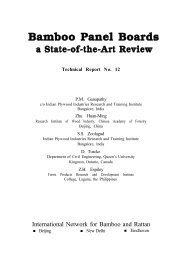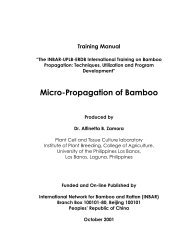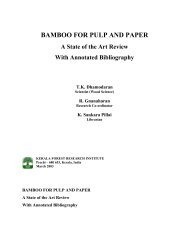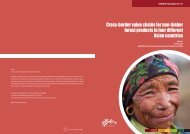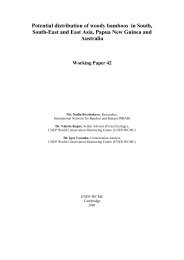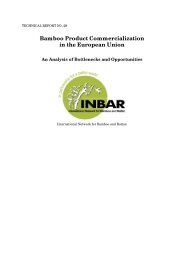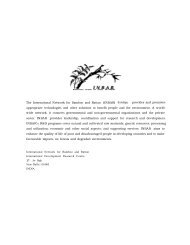The Bamboo and Rattan Sectors in Asia: an Analysis of ... - INBAR
The Bamboo and Rattan Sectors in Asia: an Analysis of ... - INBAR
The Bamboo and Rattan Sectors in Asia: an Analysis of ... - INBAR
Create successful ePaper yourself
Turn your PDF publications into a flip-book with our unique Google optimized e-Paper software.
<strong><strong>an</strong>d</strong> m<strong>an</strong>y districts <strong>in</strong> other parts <strong>of</strong> the state that were once rich <strong>in</strong> bamboo are now<br />
without it. Approximately 55% <strong>of</strong> the total productive bamboo forests <strong>in</strong> the state<br />
(approximately 8 600 km 2 ) have died after gregarious flower<strong>in</strong>g. In the study area a<br />
gregarious flower<strong>in</strong>g episode occurred <strong>in</strong> 1985, after which bamboo fell<strong>in</strong>g was b<strong>an</strong>ned.<br />
Some bamboo forests have regenerated <strong>in</strong> blocks.<br />
Household bamboo requirements <strong>in</strong> the study area are high. Average<br />
consumption <strong>in</strong> the survey blocks r<strong>an</strong>ged from <strong>an</strong> average <strong>of</strong> 155 to 250 culms/year/<br />
household. Surpris<strong>in</strong>gly, even though it is difficult to get enough good quality material<br />
from the Forest Department, farmers cultivate very little bamboo. In two <strong>of</strong> the blocks,<br />
less th<strong>an</strong> 20% <strong>of</strong> the people cultivate bamboo on field emb<strong>an</strong>kments (bunds), while<br />
<strong>in</strong> one block as m<strong>an</strong>y as 40% do so. <strong>The</strong> reasons given for not cultivat<strong>in</strong>g are the<br />
difficulty <strong>of</strong> controll<strong>in</strong>g the spread <strong>of</strong> bamboo <strong><strong>an</strong>d</strong> competition with crop pl<strong>an</strong>ts for<br />
water, light <strong><strong>an</strong>d</strong> nutrients.<br />
A large number <strong>of</strong> people extract bamboo from the forest (more th<strong>an</strong> 70% <strong>in</strong><br />
several villages) though it is illegal. About 22-29% gets bamboo from depots <strong><strong>an</strong>d</strong> a<br />
few (5-15%) buy from open markets. <strong>The</strong> Forest Department has a distribution system<br />
for supply<strong>in</strong>g bamboo to different types <strong>of</strong> users through its cha<strong>in</strong> <strong>of</strong> depots. Different<br />
groups are categorized as:<br />
● Nistars (right holders) ---- people liv<strong>in</strong>g <strong>in</strong> <strong><strong>an</strong>d</strong> near forests are supplied with<br />
bamboos for their domestic needs at concession rates. A family is theoretically<br />
entitled to up to 250 culms/year at Rs 0.25 per culm plus extraction cost <strong><strong>an</strong>d</strong><br />
forest surcharge 10 (US$1 = Rs 35.86).<br />
● Basods ---- traditional craft workers who earn their livelihood by mak<strong>in</strong>g<br />
bamboo articles such as baskets, mats, conta<strong>in</strong>ers, f<strong>an</strong>s, etc. <strong><strong>an</strong>d</strong> sell<strong>in</strong>g them<br />
<strong>in</strong> local markets. A registered Basod family is entitled to get 1 500 bamboo<br />
culms/year at Rs 0.60 (plus surcharge).<br />
● P<strong>an</strong> barejas (betel growers) ---- agriculturists who grow betel v<strong>in</strong>es need bamboo<br />
to construct support <strong><strong>an</strong>d</strong> shade structures for the betel v<strong>in</strong>e. After satisfy<strong>in</strong>g<br />
the above groups, <strong><strong>an</strong>d</strong> depend<strong>in</strong>g on availability, every P<strong>an</strong> bareja may get<br />
up to 1 000 culms at a cost <strong>of</strong> Rs 1.50 plus extra charges.<br />
● Other consumers may purchase up to 50 culms <strong>of</strong> bamboo each year from<br />
the Forest Department at rates r<strong>an</strong>g<strong>in</strong>g from Rs 4.60 to 13.75, depend<strong>in</strong>g on<br />
the culm size. Consumers who use more th<strong>an</strong> 500 culms/year are required<br />
to register <strong><strong>an</strong>d</strong> pay a registration fee. <strong>The</strong>y are differentiated <strong>in</strong>to several<br />
categories. Some users (e.g. agarbatti m<strong>an</strong>ufacturers, fruit growers) c<strong>an</strong> buy<br />
up to 5 notional tons (1 notional ton = 0.8 ton) <strong>of</strong> 1 to 2 m pieces at a time<br />
at the rate <strong>of</strong> Rs 1 115/ton.<br />
10 A new policy took effect as <strong>of</strong> 1 J<strong>an</strong>uary 1997, under which Nistars are no longer entitled to forest<br />
products, but must purchase them as needed from local markets at prevail<strong>in</strong>g prices.<br />
22



